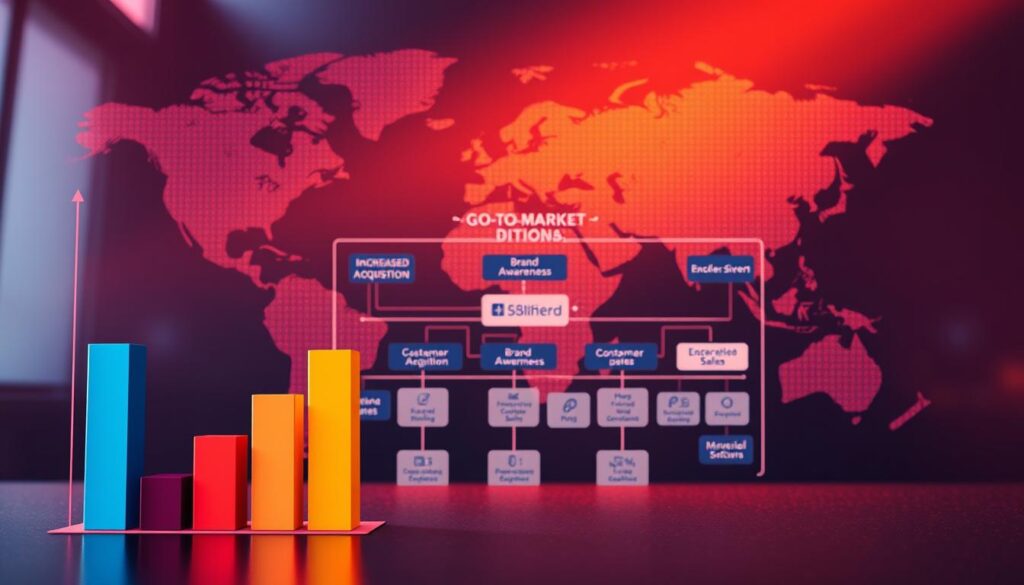Launching a product without a structured plan is like navigating uncharted waters without a compass. A well-designed go-to-market (GTM) approach acts as both roadmap and risk mitigator, ensuring teams avoid costly missteps. It defines who to target, how to position offerings, and when to execute – turning uncertainty into actionable clarity.
This methodology applies equally to physical goods, digital services, or business expansions. Unlike broad marketing plans focused on brand awareness, GTM strategies zero in on specific product introductions. They bridge gaps between departments, aligning sales pipelines with customer success metrics and product launch timelines.
Timing proves critical. Entering saturated markets or targeting misaligned audiences often stems from inadequate research. A robust framework identifies whitespace opportunities while anticipating competitive responses. It also prevents premature launches that outpace market readiness or delayed entries that cede first-mover advantages.
Key Takeaways
- GTM plans serve as launch blueprints for products, services, and business expansions
- Focuses specifically on product introduction rather than general brand promotion
- Aligns cross-functional teams to unified revenue objectives
- Prevents timing errors and audience targeting miscalculations
- Balances competitive analysis with market opportunity assessments
Introduction to Crafting a Winning Go-to-Market Strategy
A well-constructed GTM framework acts as a safety net for businesses entering new territories. It transforms vague ambitions into measurable steps, reducing risks while maximizing resource efficiency. As noted in a comprehensive guide, these plans unite cross-functional teams under shared objectives – from product development to customer onboarding.
Central to this approach is its predictive power. By analyzing historical data and competitor movements, companies can anticipate challenges before they arise. “The best strategies don’t just react – they prepare,” observes a seasoned product manager. This forward-thinking mindset helps organizations avoid costly errors like mistimed launches or misaligned messaging.
Effective frameworks also streamline communication. They ensure marketing materials speak directly to buyer pain points while sales teams reinforce core value propositions. When departments operate in sync, conversion rates improve and customer trust grows organically.
Creating go-to success requires balancing multiple priorities. Resource allocation must match market demand signals, while pricing models need competitive validation. The result? A cohesive action plan that turns market entry from a gamble into a calculated victory.
Understanding the Go-to-Market Landscape
Successful product launches demand more than intuition – they require a structured foundation. Modern market strategies rest on four pillars that guide decisions from concept to customer acquisition. These elements form a diagnostic tool, helping teams spot weaknesses before scaling operations.
Key Components of a GTM Framework
Every effective plan starts with validating product-market alignment. Teams must confirm their solution addresses urgent needs better than alternatives. Next comes precise audience segmentation – identifying early adopters most likely to convert.
Competitive analysis follows, mapping rival strengths and market gaps. Finally, distribution channels require optimization based on buyer preferences. “Over 63% of failed launches stem from poor channel selection,” notes a recent tech industry report.
Industry Trends and Market Dynamics
Emerging patterns reshape how companies deploy GTM strategies. Product-led growth models now dominate SaaS sectors, letting features sell themselves. Community-driven adoption accelerates through platforms like Discord, while AI tools predict customer behavior with 89% accuracy in pilot programs.
| Model | Best For | Key Advantage |
|---|---|---|
| Sales-Led | Enterprise Solutions | High-touch customization |
| Product-Led | Self-Serve Tools | Low acquisition costs |
| Hybrid | Complex Ecosystems | Balanced scalability |
Market dynamics dictate model selection. Industries with lengthy sales cycles often combine direct sales with digital nurturing. Consumer sectors increasingly prioritize instant gratification through seamless onboarding experiences.
The Benefits of a Go-to-Market Strategy
Effective market entry isn’t accidental—it’s engineered through meticulous planning. Organizations that implement structured entry plans achieve 3.2x faster revenue growth than those relying on improvisation, according to Gartner research. These frameworks convert chaos into controlled execution across every launch phase.

Cross-department alignment emerges as the first critical advantage. Clear role definitions and synchronized timelines prevent teams from working at cross-purposes. Marketing campaigns align with sales pipelines, while customer support prepares for post-launch demands.
Risk mitigation ranks equally high. By stress-testing assumptions during planning stages, companies identify flawed pricing models or mismatched audience segments early. This proactive approach reduces financial exposure – failed initiatives cost enterprises an average of $1.3M annually.
| Benefit | Business Impact | Key Actions |
|---|---|---|
| Team Coordination | 38% faster decision-making | Role mapping workshops |
| Risk Management | 52% lower failure rates | Pre-launch scenario testing |
| Market Positioning | 2.4x brand recall improvement | Competitor gap analysis |
Structured workflows slash time-to-market by eliminating redundant approvals and resource conflicts. One SaaS company reduced launch cycles from 14 to 6 weeks using standardized checklists.
Validating product-market fit becomes systematic rather than speculative. Quantitative customer interviews and prototype testing replace guesswork, ensuring solutions resonate before full-scale production. This precision builds customer trust while conserving development budgets.
Defining Your Ideal Customer Profile
Imagine trying to sell winter coats in the desert – that’s what happens when you skip customer profiling. An ideal customer profile (ICP) acts as your targeting compass, identifying accounts most likely to convert and deliver long-term value. This blueprint shapes every outreach effort, ensuring teams focus on prospects with both urgent needs and adequate resources.
Effective profiles blend hard data with behavioral insights. Demographics like company size and industry form the skeleton, while psychographics reveal decision-making patterns. A fintech startup’s ideal customer might be CFOs at mid-sized firms who prioritize automation over legacy systems – specific enough to guide campaigns but flexible for refinement.
Building this profile requires cross-referencing four data layers:
- Job roles and purchasing authority levels
- Common operational pain points
- Budget thresholds and growth trajectories
- Technology adoption rates
These criteria directly influence messaging tone, sales playbooks, and even product roadmaps. Teams targeting healthcare providers craft compliance-focused content, while those serving startups emphasize scalability.
Market feedback continuously sharpens ICP accuracy. One SaaS company increased conversion rates by 41% after discovering their true customer profile leaned toward HR managers rather than IT directors. Regular data reviews turn assumptions into evidence-based targeting.
Conducting Market Analysis and Competitive Research
Decoding market dynamics separates industry leaders from teams stuck in guesswork. Effective analysis transforms raw data into strategic insights, revealing where your solution fits and how competitors might respond. This process isn’t about copying others – it’s about finding unmet needs that align with your strengths.
Start by dissecting competitor reviews on platforms like G2. Filter feedback by company size – SME, mid-market, or enterprise – to understand what potential customers value most. Look for recurring complaints about missing features or pricing frustrations. These pain points often signal opportunities to differentiate.
Assessing market size and growth potential prevents costly timing errors. Entering a saturated new market demands unique angles, while emerging sectors require speed. One productivity tool gained 23% market share by launching just as remote work surged.
Build competitive intelligence through:
- Feature comparison matrices highlighting gaps
- Pricing analysis across tiers and geographies
- Customer journey maps exposing service weaknesses
This intelligence directly shapes your market strategy. If competitors dominate enterprises but neglect mid-sized firms, position your solution as the agile alternative. When reviews praise a rival’s ease-of-use but criticize support, emphasize your 24/7 service.
Regular updates keep your market strategy relevant. Set quarterly reviews of competitor moves and customer sentiment shifts. This proactive approach turns analysis into sustained advantage.
Crafting a Compelling Value Proposition
Without understanding what keeps your customers awake at night, even the best products can falter. A sharp value proposition acts as a mirror reflecting both urgent needs and tailored solutions. It transforms generic features into targeted remedies through systematic analysis and strategic messaging.

Identifying Customer Pain Points
Effective teams uncover frustrations through behavioral data and direct conversations. Surveys reveal surface-level complaints, while interviews expose deeper workflow bottlenecks. One logistics company discovered 73% of clients prioritized real-time tracking over pricing – a detail surveys alone missed.
Value matrices organize these insights visually:
| Buyer Persona | Key Challenge | Solution Impact |
|---|---|---|
| IT Manager | System integration delays | Pre-built API connectors |
| Marketing Director | Campaign ROI tracking | Automated attribution modeling |
| Operations Lead | Inventory mismatches | AI-powered demand forecasting |
This framework ensures messaging addresses specific pain points with measurable outcomes. Psychological urgency drives action – positioning solutions as painkillers outperforms vitamin-style prevention pitches by 2:1 in conversion tests.
Establishing Unique Value
Differentiation emerges when solutions align with unmet needs competitors overlook. Analyze feature gaps through customer journey mapping. A project management tool gained traction by focusing on client-facing dashboards – a capability rivals treated as secondary.
Consider these positioning strategies:
| Competitor Focus | Market Gap | Unique Angle |
|---|---|---|
| Basic analytics | Predictive insights | AI-driven trend forecasting |
| Self-service setup | Guided onboarding | Dedicated implementation teams |
Successful market strategy hinges on proving immediate relief. Highlight time-to-value metrics and tangible ROI rather than abstract benefits. When solutions visibly reduce friction, customers become advocates – and competitors play catch-up.
Developing Messaging and Positioning
Effective communication bridges the gap between product features and customer needs. Teams that master this alignment create campaigns converting 47% faster than industry averages, according to recent marketing studies. The secret lies in mirroring your target audience‘s language while highlighting solutions to their most pressing pain points.
Effective Messaging Techniques
Start by analyzing recorded sales calls and customer interviews. Look for recurring phrases describing challenges or goals. A SaaS company discovered prospects repeatedly used “time vampire” when discussing manual workflows – language later adopted in their campaign headlines.
Build messaging frameworks around three pillars:
- Terminology matching how buyers describe their needs
- Emotional triggers tied to specific outcomes
- Proof points validating speed of results
Test variations through targeted ads before full rollout. One fintech firm achieved 29% higher click-through rates by A/B testing “automate invoicing” versus “eliminate payment delays.”
Competitive Positioning Strategies
Differentiation requires understanding rivals’ weaknesses without disparaging them. Focus on unmet needs your solution addresses uniquely. For example, position 24/7 support as a lifeline if competitors offer limited hours.
Consider this comparison for healthcare software:
| Competitor Focus | Your Advantage |
|---|---|
| Basic compliance tracking | Real-time audit alerts |
| Generic templates | Specialty-specific workflows |
Align positioning with your ideal customer profile’s decision criteria. Technical buyers prioritize integration depth, while executives value ROI transparency. Tailored messaging hierarchies address these distinct pain points within the same market strategy.
How to Build a go to market strategy
A methodical approach separates thriving products from forgotten launches. Implementing a six-phase framework transforms scattered ideas into executable plans. This systematic process ensures teams address critical elements in logical sequence while maintaining agility.
Begin by crystallizing your ideal customer profile using behavioral data and demographic filters. Next, analyze competitors’ positioning gaps through review mining and feature comparisons. These insights directly shape your differentiation strategy.
Effective execution requires three foundational pillars:
- Message development rooted in customer interviews
- Quantifiable targets aligned with market capacity
- Tactical selection based on buyer journey mapping
Proven templates accelerate progress while maintaining consistency. They provide checklists for stakeholder alignment and phase gates for quality control. Teams using standardized frameworks report 44% fewer launch delays according to recent project management studies.
| Phase | Key Action | Success Metric |
|---|---|---|
| Planning | Resource allocation | Budget adherence |
| Execution | Channel optimization | Conversion rates |
| Review | Feedback integration | Iteration speed |
Accountability structures prevent initiative sprawl. Assign clear ownership for each component while maintaining weekly cross-functional syncs. This balance ensures specialized focus without siloed thinking.
Post-launch analysis completes the cycle. Capture quantitative performance data alongside qualitative team feedback. These insights refine future approaches, creating continuous improvement loops that adapt to evolving market conditions.
Selecting the Right Sales and Distribution Channels
Choosing distribution channels without customer insights wastes resources faster than pouring water into a leaky bucket. Effective selection balances buyer preferences with operational capabilities. For complex new products, direct sales teams often deliver better results than automated systems. Simpler solutions thrive through self-service platforms requiring minimal human interaction.
Sales Strategy Options
Sales-led models excel in lengthy sales cycles where trust-building matters. Dedicated sales teams use consultative approaches to navigate multi-stakeholder decisions. This works best for enterprise software or customized solutions requiring technical demonstrations.
| Model | Best Fit | Key Metric |
|---|---|---|
| Sales-Led | High-ticket items | Deal size |
| Product-Led | Mass-market tools | User activation rate |
| Hybrid | Mid-market solutions | CAC payback period |
Product-led strategies reduce dependency on sales teams through freemium tiers and viral features. One project management tool achieved 80% organic growth by letting users invite collaborators for free.
Channel Distribution Models
Partnerships accelerate new product adoption in unfamiliar regions. Resellers provide local market knowledge, while distributors handle logistics. Strategic alliances with complementary brands create bundled offerings that simplify buyer decisions.
| Channel Type | Advantage | Consideration |
|---|---|---|
| Resellers | Regional expertise | Margin sharing |
| Distributors | Inventory management | Payment terms |
| Alliances | Cross-selling | Brand alignment |
Match channel choices to your sales cycle complexity and customer support needs. Technical products often require direct engagement, while standardized items benefit from third-party networks.
Leveraging Digital Marketing Channels and Social Media
Digital platforms have reshaped how businesses connect with their audiences. Unlike traditional methods, modern marketing channels allow precise targeting and real-time performance tracking. This shift demands strategic alignment between content formats and platform-specific user behaviors.
Content Marketing Tactics
Effective campaigns start by mapping content types to buyer journey stages. Educational blog posts attract early-stage researchers, while case studies convert decision-makers. Platforms like LinkedIn excel for B2B engagement, whereas Instagram drives visual product discovery.
Social media amplifies reach when paired with SEO-optimized assets. Short-form videos explaining product benefits see 3x higher shares than text posts. Always tailor messaging to your target audience‘s preferred communication style – technical whitepapers for engineers, success stories for executives.
Data-driven refinement separates winners from noise. A/B test headlines across social media platforms to identify high-performing hooks. Tools like Google Analytics reveal which marketing channels drive qualified leads versus casual traffic.
FAQ
How long does it take to develop an effective market entry plan?
Most companies require 6-12 weeks to build a robust strategy, factoring in customer research, competitive analysis, and channel validation. Complex industries like enterprise SaaS often need extended discovery phases to address regulatory requirements and technical integrations.
What metrics prove a product launch strategy works?
Key performance indicators include customer acquisition cost ratios, conversion rates at each sales funnel stage, and market share growth. Brands like HubSpot track lead-to-customer velocity and content engagement rates to gauge positioning effectiveness.
Can existing businesses benefit from overhauling their approach?
Absolutely. Salesforce revamped its channel strategy in 2019, boosting partner-driven revenue by 37% within 18 months. Regular audits of buyer journey alignment and channel performance help mature companies maintain competitive advantage.
How do pricing models influence channel selection?
Subscription-based products often perform better through digital self-service portals, while high-ticket solutions require direct sales teams. Microsoft’s shift to cloud licensing directly impacted its retail distribution partnerships, emphasizing enterprise account management.
What role does content play in customer acquisition?
A> Top-performing organizations allocate 40% of their marketing budget to educational content. Case studies from Drift show targeted thought leadership pieces can shorten sales cycles by 22% when aligned with specific buyer pain points.
When should companies adjust their core messaging?
Major shifts occur during market expansions or product pivots – like Adobe’s transition from boxed software to Creative Cloud. Continuous message testing through A/B campaigns and sales team feedback prevents positioning drift.
How crucial is cross-department alignment for execution?
A> Zappos attributes 31% faster time-to-market to integrated product, marketing, and sales teams. Shared KPIs and weekly progress syncs prevent siloed decision-making that derails 68% of product launches according to Gartner research.



